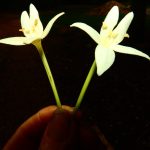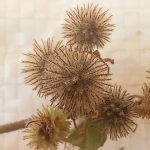TREE LIFE 539
JULY 2025
PLANNED EVENTS:- JULY
Since inclement weather or other issues may vary our plans, WhatsApp Tony Alegria on 0772 438 697 to join our WhatsApp group for last minute updates.
Saturday 5th July 2025:- visit to the National Botanic Gardens. Meet at 8.30 in the main car park and join us for a morning looking at trees that catch our interest.
Sunday 20th July 2025:- Main outing to Mazoe Botanical Reserve at Christon Bank
Directions: Take the Mazowe Road out of Harare turning right to Christon Bank about 22.5 km from Harare. Follow the tarred road right down ignoring all the various turn-offs to right or left. Continue to the end of the tar (± 9 km) and park in the parking area on the right (labelled the Botanical Reserve).
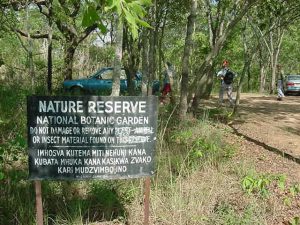
We will park at MyTrees ($2 entry fee may be needed) for a 9.30 start, but will head north across the small stream towards Split Rock and walk back up the small valley west of the view point. Don’t worry, no climbing is involved and the walk is shorter and flatter than walking down to the Mazowe River and back.
Christon Bank is an area of rocky hillsides and Brachystegia boehmii dominated woodland with fantastic views. Don’t forget the sunblock, and make the most of the day by bringing a chair, lunch, and cooler bag.
You do not have to be a member to join us for the day.
STILL NEEDED
We are often asked by folk who have a real use for a copy of “A New Zimbabwean Botanical Check List of English and African Plant Names” (The vernacular names book) by L J Mullin. These were originally given to members at no cost, but if you find you are not using yours, please hand it over to Tony or one of the committee.
NOTE: For the purposes of our newsletter, all species of acacia have been given their specific genus name, Vachellia or Senegalia.
REPORTS FROM PREVIOUS OUTINGS
Saturday 7th June 2025:- National Botanic Garden Outing
By Jan Van Bel, photos by Jim Dryburgh
It was a cloudy winter day when 8 people gathered at the carpark of the gardens. A good number to get close to the trees and close to each other. Our leader Tony had made the plan to go visit the north-east part of the park, or at least a few square meters of it. It’s a place where few of us have ever been. It would have been difficult to get there on foot, given the old legs of some of us and the distractions by all that interesting green on our way to this spot. We were given permission to drive there by car so we all fitted into 2 cars and a few minutes later we were botanising.
A few big msasas were waving to us. As we are used to just get an impression of a tree which is very familiar to us, we slowly start forgetting the identification features. Tony now asked each of us to name a specific characteristic of the msasa without looking at it. It’s always amazing how many details one arrives at.
We then looked at a tree that was labelled ‘’U’’ in front a number. This is now our system to locate a tree that has been examined but remains ‘’U’’nknown or is still not confirmed 100% correct. This tree had all the features of Berchemia discolor, bird plum. The reason it was given a “U” number, was because of its unusual leaf shape, being more round and smaller.
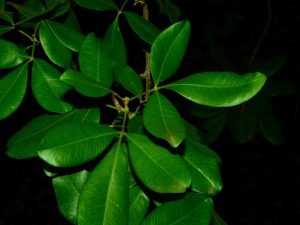
Vepris trichocarpa
Close by was a Pittosporum viridiflorum with unusually light coloured leaves. The one 10m further on was much greener, the colour we identify it with.
Vepris trichocarpa, furry-fruited vepris (still named Teclea in the old books) was the next one we looked at. This is a small tree with trifoliate leaves, flaky bark and hairy fruit, found in the south-east of the country. Tony now started explaining the basics of leaf morphology to our two new members Kennedy and Charity.
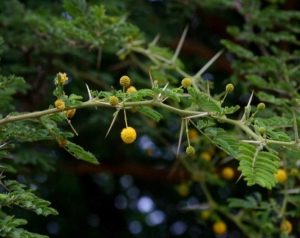
Vachellia nilotica: photo Bart Wursten
The Vachellia nilotica, the scented pod acacia has another type of leaf and our new members got a speed-course in tree identification.
We now wanted to show how to use the dichotomous key in the acacia book from Timberlake & Co. This system of identification is sometimes difficult to use if some features are absent because of the season, and once again we arrived at the wrong conclusion. We knew that it couldn’t be a Vachellia sieberiana, the paperbark acacia, a tree we know well.
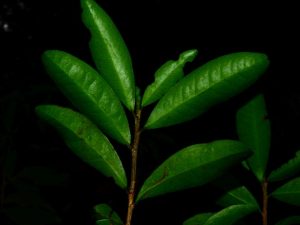
Erythroxylum emarginatum
A different type of leaf could then be found on the Erythroxylum emarginatum, common coca tree. It has simple leaves with a notch in the apex. Next to it was another simple leaf tree, more like a shrub, was a Pavetta gardeniifolia, common bride’s bush. It has bacterial nodules (black dots) in the leaf which gives it that typical scent, for most people not very likable.
Another simple leaf, Ziziphus mucronata (buffalo thorn) and compound leaf, Pistacia chinensis finished the lesson in morphology for our new members, who showed a lot of interest and were happy to add some scientific and English names to their knowledge of Shona tree names.
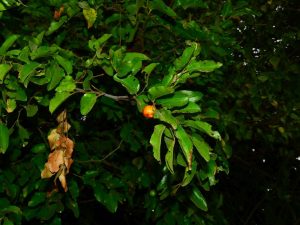
Ziziphus mucronata
buffalo thorn (a simple leaf)
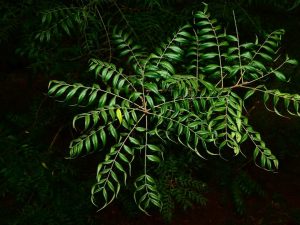
Pistacia chinensis
(paripinnate compound leaf)
Main outing Saturday 28th June 2025
The report on this outing will be included with next month’s Tree Life.
FROM MEMBERS TO THE WALRUS AND THE CARPENTER
Proposed Nyanga National Park Ecosystem Protection Project
Friends of Nyanga National Park edited by Linda Hyde
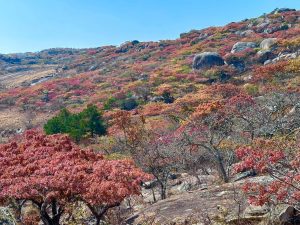
View of the early spring Msasa flush from
Cedar Peak Cottage, Nyanga
INTRODUCTION
The ecosystems found within Nyanga National Park are unique in Zimbabwe with many of the species of plants being endemic to Nyanga or with limited distribution. The best known example is the dwarf Msasa’s (Brachystegia spiciformis) which are well known for their magnificent show of bright red foliage at the start of the summer season. The parks ecosystem is also an important habitat and breeding ground for birds, particularly the endangered Blue Swallow.
Due to commercial forestry activities on most borders of the park over a long period, it has been invaded by certain exotic woody plants. The main species are pines and the wattles, notably the Mexican Pinus patula, and Acacia mearnsii, Acacia dealbata and Acacia melanoxylon all of which are native to Australia. They all thrive in the Nyanga climate and, being exotics, are not kept in check by natural predators, competition, etc. as they would be in their native habitat and have become the dominant vegetation.
If this situation is allowed to continue there will be little or none of the indigenous vegetation left in years to come – a great loss for Zimbabwe and for the world.
ACTIVITIES SO FAR
The Friends of Nyanga National Park have recently spent 4 years attempting to eliminate woody exotics have taken place. Firstly by treating individual plants (particularly wattle) with arboricide to kill them then by allowing timber concerns to come into the park and harvest mature trees.
These measures have met with only partial success with the long-term success unlikely. The reasons for this are:
- The seed reserves in the ground where the exotics grow are enormous;
- Commercial tree cutters are only interested in mature trees and did not cut out any of the smaller trees;
- A number of the areas where exotics have established themselves are remote and in rough terrain and therefore difficult to reach.
Currently, National Parks have embarked on a new initiative, a business arrangement with a private company with an agreement to clear wattle as follows:
- 2,000 hectares of wattle is to be cleared, no matter what size;
- All cut wattle plant material left in the area cleared must be burned.
- The area cleared must be seeded with grass seeds obtained from the vegetation surrounding the cleared area.
So far, we understand that around 450ha of wattle have been cleared with National Parks deploying as many workers as possible to eliminate seedlings which emerge. However, funds are limited and it is doubtful that they will be able to keep up in the long term with the necessary seedling elimination.
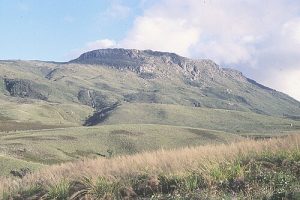
Nyanga grasslands on the slopes of Mount Nyangani
NEW PROPOSAL
This new proposal is made understanding that funds are limited and this is likely to be an ongoing activity for the foreseeable future. It will complement the process outlined above resulting in the protection of the various vegetation types occurring in the park.
It is proposed that:
- relatively small areas of each vegetation type in the National Park are identified;
- these are accessible to interested public;
- that all exotic vegetation is eliminated from these areas;
- and that they are maintained in ‘pristine’ condition into the future.
The areas will vary in size according to vegetation type but will not be fenced so that normal animal and other activity is not interrupted and the initial capital costs and future maintenance costs are reduced.
What will be required is the erection of permanent physical corner markers so that the boundaries of the delineated area are clear. The GPS points of these markers will be recorded.
VEGETATION TYPES
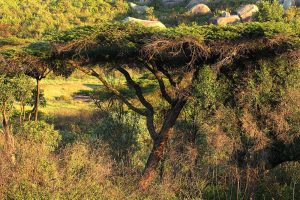
Vachellia abyssinica woodland near Juliasdale; photo Bart Wursten
The following vegetation types will be included
- Grassland
- Montane Miombo woodland
- Shrub community with Hypericum revolutum and roeperianum.
- Shrub community with Leucosidea serecia.
- Vachellia (Acacia) abyssinica woodland
- Mulanje cedar (Widdringtonia nodiflora) community
- Riverine vegetation containing tree ferns (Cyathea dregei)
- Gulley tropical forest.
Additional types may be added after consultation with the ecologists from National Parks.
COSTS
At this point there has been no assessment of costs. Once the proposed project is approved by National Parks, the Friends of Nyanga National Park undertakes to source the necessary funds.
Nyanga National Park is an important and unique area in our country.
Further information and queries: Rob Kelly (0772 249198, kelly@zol.co.zw)
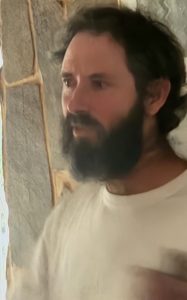 An Afternoon With The Self Styled “Naked Botanist”
An Afternoon With The Self Styled “Naked Botanist”
Dr. David Gwynne-Evans,
CEO of CASABIO.org (The Home of Biodiversity)
The afternoon of the 30th of May saw the arrival of Capetonian botanist, Dr David Gwynne-Evans, and his companion, Montessori teacher Shereen Young, to Mark Hyde’s lounge. Packed to near capacity with nearly 20 Tree Society members, the evening opened with a reading of a post David had written whilst inspired by the scanning and dissection of the carnivorous Utricularia stellaris plants floating on the dam at Matopos National Park.
 David enthused about the wonderful diversity of plants they’d encountered in Zimbabwe thus far and provided an overview of the Casabio.Org, Citizen Science Platform he and his team are developing to ingest observations such as these. He revealed that the 20 years of development has culminated in this current technological behemoth which has thus far taken two years to put together.
David enthused about the wonderful diversity of plants they’d encountered in Zimbabwe thus far and provided an overview of the Casabio.Org, Citizen Science Platform he and his team are developing to ingest observations such as these. He revealed that the 20 years of development has culminated in this current technological behemoth which has thus far taken two years to put together.
Based on a complex union of open-source components, it is aiming to revolutionize African biological sciences and pave the way for a more complete and collaborative means of discovering and documenting our flora and fauna. One issue that Casabio aims to tackle through their platform is the destruction of road verges in the name of maintenance. This is an issue that currently destroys millions of kilometres of roadside vegetation across Africa, but if handled appropriately, has the potential to create the longest reserve in the world!
To this end, one initiative is incorporating images from books into a central publicly accessible portal. Currently they have extracted images from 66 botanical books covering over 10 000 species. These books are searchable both within and between books and may be ordered alphabetically by either genus or family (https://casabio.org/browse/books).
Another initiative is that of Project Bety (Biological Etymologies) – aiming to unify all etymologies into one site (https://casabio.org/browse/etymologies). Last month they implemented their second last component, the GIS module, meaning that now users may setup sites such as the botanic garden, and start building up a digital field-guide or species list for that land.
Most recently they have integrated RAW images in their pipeline, meaning that their portal can now ingest highest quality RAW images of plants or animals and upload them directly via the Casabio workflow. This paves the way for Casabio becoming a photo-stock library and a means for Tree Society members to fund their passion by selling their images.
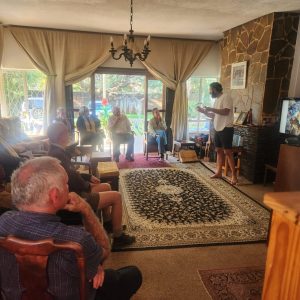 After a break, David broke out the fun stuff, showcasing images of his travels and adventures through Africa. Traveling through Kenya, visiting high mountain peaks by motorbike, he was subject to almost daily wipeouts, one being off a cliff several metres high. His leg was only spared from being crushed by the falling bike by his backpack strapped to the back of it that acted as cushioning. He expounded about the elements in common between mountains, such as the giant lobelias, as well as endemic species.
After a break, David broke out the fun stuff, showcasing images of his travels and adventures through Africa. Traveling through Kenya, visiting high mountain peaks by motorbike, he was subject to almost daily wipeouts, one being off a cliff several metres high. His leg was only spared from being crushed by the falling bike by his backpack strapped to the back of it that acted as cushioning. He expounded about the elements in common between mountains, such as the giant lobelias, as well as endemic species.
He also showcased findings from his collaborative research with Dr Padraic Flood in collecting and researching the Thale Cress, Arabidopsis thaliana, on multiple mountain peaks throughout Africa. They found tremendous levels of variation within Africa that are equal to or exceed that of the rest of the continents, suggesting wonderful genetic structuring between mountains.
David wrapped up by thanking the members for their financial contributions to his endeavours, and encouraging them to follow his planned 2 year travels through Africa, Europe and America on https://casabio.org/casabio-chronicles.
He also welcomes interested personal contact via capebio@gmail.com or Whatsapp on +27 72 368 9244.
Getting Reacquainted With Some Sundews, And Other Odds & Ends
By Ian Riddell
On 24th May, 2025, we were on a BirdLife walk at Bally Vaughan in the Enterprise area, northeast of Harare. I wasn’t paying too much attention to the plant life, until I noticed a large Red Mahogany, Khaya anthotheca, on the stream where a few Syzygium guineense were also growing with some white flowered Rhamphicarpa in a soak-zone over the granite below one of the dams.
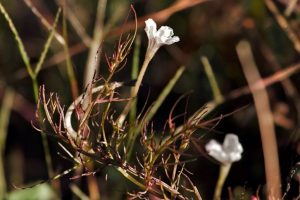
Likely Rhamphicarpa fistulosa, the pedicel looks to be well over 1 cm in length
These herbs belonging to the Orobanchaceae or broomrape family, called the Fishing-net plant, require pedicel length and detail of the capsule to identify to species level. I wasn’t aware of that at the time, but re-examining one of the photos, it can be seen (just) that the pedicel is relatively long and much longer than the 1-6 mm of Rhamphicarpa brevipedicellata. This would make them Rhamphicarpa fistulosa, but to be absolutely sure they deserve a future visit to take closer look with this in mind.
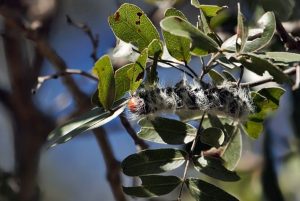
Early instar stage of the
Diverse Emperor Imbrasia ertli
After a little wandering around the main complex, we met with Clemence, who took us on a stroll into the game park. Into the miombo we went, strolling along the dirt road. There was much Julbernardia globiflora and Clemence pointed out some caterpillars munching on the leaves, thinking them to be Mopane Worms. However, Mopane Worms would be unusual in this area and are hairless and quite colourful, whereas these were black with a red head and long white hairs, making them the Diverse Emperor (Imbrasia ertli). The Diverse Emperor feeds on miombo, Julbernardia and Msasa Brachystegia spiciformis, and is also collected a food and known as ‘chini’.
We continued down the road and came to the crossing of the stream from Mermaids Pool. The road here wound over bare granite and, in a fissure created by the water, a Common Wild fig Ficus burkei twisted its roots down to the bottom. Sundews were on my mind… I had looked in the soak zone amongst the Rhamphicarpa but found nothing, as I remembered they grew upstream at Mermaids Pool, and asked Clemence if he knew of them – he did and a spot was just some 100 metres to our right!
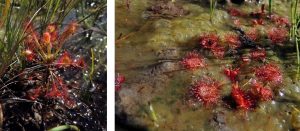
Drosera madagascariensis and a few Drosera burkeana
Up the road we went and turned right along the edge of a grassland and down towards the stream. The ground dropped quite steeply and was already quite dry and pock-marked with zebra tracks, too dry for Drosera. Searching upstream through the grass, we came to a steep bank where water was oozing out, another soak zone, and there they were. Quite a few Madagascar Drosera, Drosera madagascariensis, emerged from the muddy ground, some with scapes bearing flower buds, and also a few Burke’s Drosera, Drosera burkeana, sitting in shallow stagnant water.
It was nice to see healthy vlei lines through miombo on the property, unaffected by human pressure and agriculture. Harare wetlands are severely impacted, with sewage in many, and urban development in what were previously designated ‘green spaces’, and Drosera is unsurprisingly extinct – wetland and streambank cultivation is everywhere and uncontrolled on every system except Monavale, Haka Park and Mukuvisi.
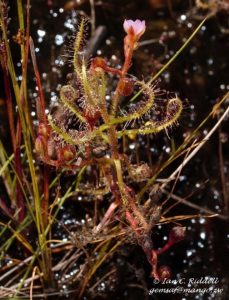
Drosera indica, Masembura
Drosera indica was collected in Salisbury in 1920 (Eyles) and at Cleveland in 1946 (Wild), D. burkeana in Salisbury in 1931 (Brain) and D.madagascariensis also at Cleveland in 1944 (Hopkins)
The closest localities in recent decades are around Domboshawa, Ngomakurira and Chinamora CL/Masembura CL, where seepage zones from granite outcrops still remain, but how are those places going to fare with the burgeoning population? Where I photographed Drosera indica and Drosera burkeana east of Ngomakurira in May 2014, Google Earth shows it is now developed and the habitat is gone!
More can be read in Tree Life No. 254.
Our walk through the miombo woodlands was quiet, bird-wise, with one tree I recall on the roadside being the Snake-bean Bobgunnia madagascariensis. We went up a granite outcrop with a Large-leaved Star-chestnut Sterculia quinqueloba on top and lots of Xerophyta and Resurrection plants Myrothamnus, waiting for the next rains to come alive again. On these shallow soils were quite a few Three-forked Euphorbias Euphorbia matabelensis, a common tree here and south of the road where we went later. Down into a drainage line and in the area was Ochna schweinfurthiana, Acacia amythethophylla, Peltophorum africanum and lots of signs of baboon activity with everything loose, plus those tongues of dried moss creeping down the granite, having been turned over in the search for scorpions and anything else tasty.
We had come nearly full circle and stopped on the stream down from the centre where there was suddenly quite a lot of bird activity, now that the morning had warmed a bit and we were out of pure miombo. In a big clump of Searsia longipes longipes were lots of birds and our best bird of the morning, a Green-backed Honeybird. The ecotone here was scattered with the dried remains of Lantana camara and it was good to see that an attempt was made to clear it, but it’s a never-ending battle and there was still quite a bit along the stream.
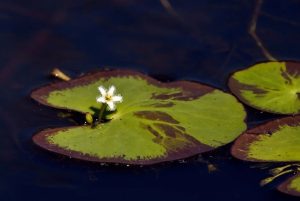
Floating Heart
Nymphoides senegalensis
We wended our way back through thick grass and along the edge of the lower dam, spotting Egyptian Geese on stumps and Mallards (hopefully pinioned) feeding in the Water Hyacinth Pontederia crassipes (formerly Eichhornia crassipes). Before heading south of the road to the farm dams we spent some time pulling off our heavy load of Blackjacks Bidens pilosa and Silver-leaf Desmodium uncinatum!
I hadn’t been to the farm side before and we parked on more exposed granite to be greeted by some confiding zebra walking up from a dam. Leaving them as car guards we headed down to the wall of this smallish dam. In the pools of shallow water was an attractive display of Floating Heart Nymphoides senegalensis, the green leaves with patches of purple, and still sporting frilly-edged white flowers.
We headed up through the bush bordering the large Strathlorne dam and the annual Crotalaria cephalotes caught my eye. It is quite striking with a spreading circle of linear leaves crowned with and a dense head of flowers in the middle, reminiscent of the fruit of the Mukwa in general arrangement and other plants with ‘fried egg’ in their name. I had seen it before but never identified it, so thanks to Mark for the name.
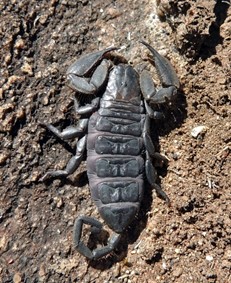
Mozambique Rock Scorpion
Hadogenes granulatus
When we emerged onto open granite; the first rock Clemence turned over revealed a Mozambique Rock Scorpion Hadogenes granulatus. No rocks being turned over in this area was an indication that there were no baboons here and the scorpions could exist in peace!
Other plants I recall passing were Violet Tree Securidaca longipedunculata, a big bushy Dalbergia melanoxylon, Wild Rubber Diplorhynchus condylocarpon (or was that on the north side of the road?), another fairly big Ficus burkei on boulders, some very spiny cacti and a fruiting Leucaena leucocephala (evidence of man’s influence), and next to the Leucaena for direct comparison was an African Wattle Peltophorum africanum looking just the same except for the fruit! Tall and hidden and supported by the branches of the African Wattle was a Parrot-beak Gladiolus Gladiolus dalenii dalenii sporting apricot-pink flowers.
This area was more varied than the miombo woodland and I’ll no doubt suddenly remember more trees later, but this short list will have to do. I picked a nice-looking fruit from a Strychnos spinosa but on cracking it open it was rather mushy inside and laced with maggots (had eggs been laid through a tiny crack?), so that meal was vetoed. The zebras were quietly gathered around the cars on our return.
And now for something completely different, a problematic Drosera pair…
Just for interest I thought I’d add a bit on cultivated Drosera.
What many growers call a ‘weed’, either don’t mind them or hate them, are Drosera spathulata and Drosera tokaiensis. They are both acaulescent and very much alike, so much so that there are endless forum discussions on which is which.
In Tree Life 253 I mentioned – “The reputed Drosera spathulata which I have which is a prolific flowerer with flower stalks all year round – as many as 5 growing at a time!”, but, although the ‘h’ is frequently included (even in books), it should be spatulata, a reference to the spathulate leaves. You can see the source of the spelling problem! It has a large range and occurs naturally throughout Southeast Asia, southern China and Japan, Micronesia, Papua New Guinea, eastern Australia, Tasmania and New Zealand and is quite variable, grows easily, is very hardy and produces copious amounts of seed that pop up plants where they aren’t wanted.
Drosera tokaiensis is native to Japan and is considered to be a natural hybrid of Drosera rotundifolia and Drosera spatulata. Then, I suppose, there is the problem of cultivars amongst growers, much like many garden plants, and misidentifications of both spatulata and tokaiensis online.
Someone send me a packet of sphagnum moss from New York so long ago that I can’t remember exactly when – probably at least 20 years ago. Whilst seeds from other species didn’t take and may be fussy about light and temperature levels, tokaiensis burst up all by itself and has thrived ever since! Yes, it is now thought that I have tokaiensis (that’s not a disease).
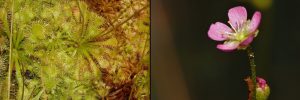
Drosera tokaiensis and flower, I. Riddell
As someone online has said, “In many cases, it may be more appropriate to simply label it as Drosera damnifiknow”!
Seeds in my Socks
By Mark Hyde; photos by Mark Hyde and Bart Wursten
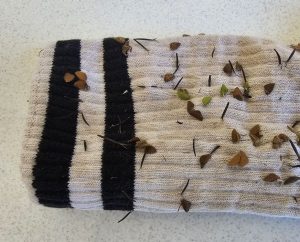
Everyone is familiar with that prickly sensation in the aftermath of a walk in the bush. Seeds build up in your socks often penetrating into your skin around the ankles.
Clearly, this is a mechanism for seed dispersal, but which species of plant cause this? And how does the attachment occur?
This is a list of species personally observed in my own socks from locations around Harare only.
- Bidens pilosa – Blackjacks
Probably the greatest offender of all, the seeds of this species bear 2-3 bristles at the apex, each of which has backwardly directed barbs which dig into the sock material. This attachment is therefore at one end only and this can be seen in the above image; the body of the seed being raised above the surface.
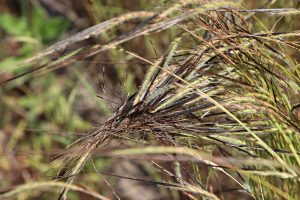
Heteropogon contortus – Spear grass
- Heteropogon contortus – Spear grass
This is probably the most painful sock-loving species as the sharply pointed base of the spikelets go straight through socks and into the skin.
Less painful grasses are species of Aristida (Bristle grasses sometimes called three-awns) and Chloris pycnothrix (Spiderweb grass). In all such cases the fruiting body has a sharp base and backwardly directed hairs or bristles which mean the seeds tend to move in deeper and cannot easily be released.
- Achyranthes aspera – the Devil’s horsewhip
In this species the fruits are arranged vertically pointing downwards along the stem. Brushing against this plant with bare legs causes the seeds to dig painfully into the skin, often in lines as if one has been whipped.
- Triumfetta species
These species bear mostly spherical fruits covered in bristles which may be hooked or have a tuft of hairs at the apex and readily attach themselves to passing humans.
- Desmodium uncinatum – Silverleaf Desmodium
Along with the Blackjack, this is one of the very worst species. The fruits are segmented and split transversely into ‘articles’ containing individual seeds. The fruits are covered in hooked hairs but not only are the fruits but so too are the leaves and stems. Because the plants can be quite tall, they readily attach not only to socks, but also shoes, hairy legs, shorts, bare arms and shirts and one can quickly pick up a lot of plant material.
- Cynoglossum lanceolatum – Houndstongue
This species and the next become attached by means of sticky fruits.
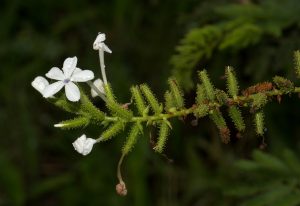
Cynoglossum lanceolatum – Houndstongue
-
-
-
-
-
-
-
-
- Plumbago zeylanica – Wild white plumbago
-
-
-
-
-
-
-
Another sticky species. There is a lot of this which has been introduced into the National Botanic Garden, and it is easy to pick up on our monthly walks.
Do keep an eye on your socks and if any more species turn up, I will cover them in a future article.
IN REMEMBERANCE
It is with sorrow we have to report the passing of 3 of our members in the last month. Vic Gifford, Richard Oulton and Marilyn Dickinson. Their contribution to the life of the society will be missed and we would like to send our condolences to their families.
SOCIETY COMMITTEE AND CONTACTS
Chairman Tony Alegria tonyalegria47@gmail.com 0772 438 697
Vice Chairman Mark Hyde mahyde@gmail.com 0772 233 751
Honorary Treasurer Bill Clarke wrc@mweb.co.zw 0772 252 720
Secretary Teig Howson teig.howson@gmail.com 0772 256 364
Venue Organiser Ann Sinclair jimandannsincs@zol.co.zw 0772 433 125
Committee Member Jan van Bel jan_vanbel@yahoo.com 0772 440 287
Committee Member Sibusiso Malunga busimalunga@yahoo.com 0775 889 898
Tree Life Editor Linda Hyde Lmharwin@pentact.co.zw 0772 232 075
Tree Society Website https://treesociety.org.zw/
Tree Society Facebook https://www.facebook.com/groups/ztreesociety/
Flora of Zimbabwe: https://www.zimbabweflora.co.zw/
Flora of Tropical Africa: https://plants.jstor.org/collection/FLOTA


